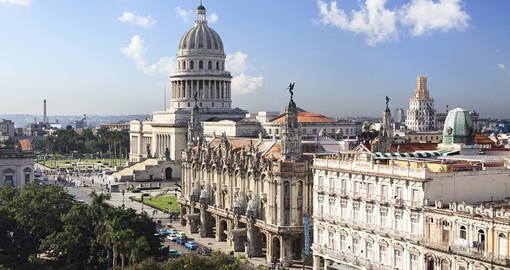Cuba History
In pre-Columbian times, there were three distinct tribes that inhabited modern-day Cuba. The Guanahatabetes, Ciboneys and Tainos were ocean travellers who established themselves as farmers, hunters and fishermen. Columbus arrived in 1492 and with him came diseases that almost completely decimated the population. Without a thriving native population, it was Spanish culture that flourished including language and religion.
For the next two centuries, a colony was established, yet Cuba remained for the most part a stopping point for the Spanish on their visits to the Americas. Spanish settlers were followed by the French and the area soon became a spot for growing sugarcane. With the sugarcane came slaves to work the plantations. As sugarcane could be grown throughout the island, it quickly became Cuba’s greatest cash crop. By the 19th century, Cuba was the major sugar producer in the world which again attracted the attention of the Spanish. While this prosperity had several benefits, it also helped to delay Cuban independence.
Late in the 19th century were two wars of independence that had major impacts on the country. The Ten-Year War from 1868-1878 saw loyalties in Cuba begin to change. A horrible war, it sparked Cuban nationalism that was not easy to silence. The second began in 1895 and ended only after the United States joined the conflict. Despite withdrawing from Cuba in 1901, the United States maintained both political and economic control of the country. As a result, Cuba became increasingly dependent on the US.
The 1930s witnessed revolutionary movements that saw Sergeant Fulgencio Batista Zaldivar succeed in overthrowing the US-backed regime of Carlos Manuel de Céspedes. Batista became president from 1940-1944 and ruled as a dictator from 1952-1959. Fidel Castro, a communist revolutionary and politician, overthrew Batista and in doing so established a communist state which further hampered relations with the United States.
In October 1960, the United States imposed an embargo on Cuba, fully severing diplomatic relations by January 1961. In April of that year, President Kennedy and the US embarked on one of the most infamous and unsuccessful military invasions in history. The Bay of Pigs was a CIA-organised operation that was supposed to see anti-Castro rebels invade the island. As the invaders were captured and killed, it quickly became apparent that the US was behind the plan and the Bay of Pigs was ruled a disaster. Soviet missiles were installed in Cuba that could hit targets in the United States and President Kennedy implemented a naval blockade on Cuba. The world was on the brink of nuclear war before Khrushchev and Kennedy reached a settlement.
The missiles were dismantled but Castro gained international attention because of his alliance with the Soviet Union. When communism fell in the 1990s, Cuba no longer had Soviet support and the economy was severely threatened as the US embargo was still in place. When Fidel Castro took ill in 2006, his brother Raúl Modesto Castro Ruz took over control of the country.
At times Cuba seems stuck in a time warp that is at odds with the fast-paced movements of the rest of the world. Despite this, tourism remains the biggest industry in the country. A place of beautiful beaches, fascinating history, colourful culture and interesting people await those who venture to this unique island destination.
Get a Trip Quote Order a Brochure

















